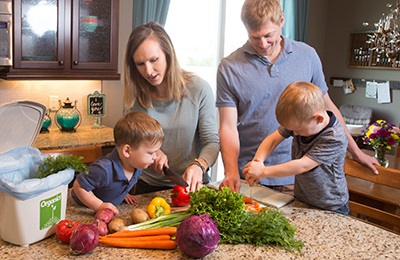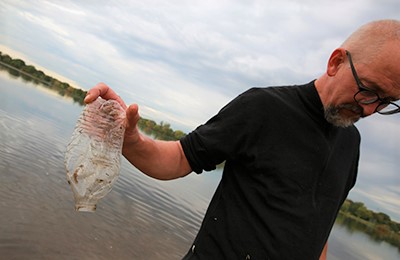How to live a lower waste lifestyle: insights from Zero Waste Challenge participants

Every year, Hennepin County offers a personalized, eight-month Zero Waste Challenge in which our waste reduction and recycling specialists work one-on-one with households to assess the waste generated in their homes, develop a customized waste-reduction plan, and make low-waste lifestyle changes. And each year, the participating households achieve impressive results.
Households reduce their waste on average by about one-quarter to one-third. By the end of the challenge, they recycle or compost 60% to 70% of their waste — which is much higher than the county average of about 45%.
Reducing emissions by reducing waste
Creating new products requires energy — to harvest raw material, process it, manufacture it, transport it, and sometimes, to use it. When looking at emissions that show how they are tied to the production of materials and goods, producing and transporting goods is associated with 45% of global emissions.
This underscores the importance of waste reduction and thoughtful consumption.
Practical and successful ways to live a lower-waste lifestyle
Many people are interested in taking steps to prevent waste, declutter, and recycle more, but aren’t sure where to start.
By taking an in-depth look at the goods we buy and waste we create, the Zero Waste Challenge helps participants uncover opportunities to recycle more and reduce waste.
So how do they do it? Here are some actions that participants said had a significant impact on reducing waste.
Improving recycling and getting started with composting

Most of the participating households use some form of composting — curbside collection, drop-off, backyard, or a combination of methods — to achieve high recycling rates. This isn’t surprising considering that 25% of our trash is organic materials, including food, food-soiled paper, and compostable products, that could be put to better use as compost. In fact, participating in organics recycling is the best opportunity to reduce our trash.
Households also spend time learning about wish-cycling (and stopped doing it!). And participants expand what they are recycling by collecting plastic film for recycling or bringing waste to a Hennepin County drop-off facility.
Eliminating disposables

We’ve gotten used to the idea that disposable equals convenience, so single-use, disposable items are common in our lives. Replacing them with durable, reusable products means we save energy and resources, use higher quality goods, and reduce the amount of waste we have to deal with.
Participating households have found numerous ways to replace disposables with reusables. Some examples:
- For personal care: Using reusable bathroom cups, cleaning cloths, cloth diapers, face wipes, shaving razors, and menstrual products
- In the kitchen: Using reusable napkins and coffee filters and avoiding snack-portioned foods
- While on the go: Bringing bags for groceries and produce, a reusable coffee mug at work, and to-go containers to restaurants
Preventing waste in the first place

Living a low-waste lifestyle often involves thinking and planning ahead to avoid waste.
Participating households have taken steps to get off junk mail lists (our Hold the Mail brochure (PDF) can help) and cut back on online purchases.
They started making choices about packaging at the grocery store, buying from the bulk section using reusable containers, and avoiding single-serving snacks.
They got better at meal planning, started cooking more food from scratch, created a designated “eat first” spot in the fridge, and used the freezer to preserve food instead of wasting it.
Learning new skills and making your own

Many households have learned new skills that help them avoid waste. This includes constructing a new sidewalk with free, reused pavers, darning socks, replacing and fixing a car transmission, and repairing a swinging chair.
Households also find things they can make at home to avoid packaging. This includes green cleaning products, beeswax wrap, yogurt and butter, and spice mixes.
Sharing what you’ve learned
An important way to have a broader impact is to share what you’re doing with others. Whether it be family, friends, or neighbors, sharing your experiences and expertise is a great way to help others feel excited and empowered to reduce waste.

Some participants have gone on to become Community Recycling Ambassadors to have a broader impact in their community. Others have given presentations to community groups or started conversations with local businesses like grocery stores and gym owners about waste reduction.
Participants had many suggestions when asked what actions they would recommend to others. If you’re not sure where to get started on your journey to a lower waste lifestyle, give one of these a try!
Participate in the next Zero Waste Challenge
Past participants have called the challenge eye-opening and a conversation-starter and said it both educated them and pushed them into action.
Participating households commit to attending an introductory webinar, setting waste reduction goals, tracking and reporting progress toward their goals, attending educational workshops, meeting with county staff during the challenge, and making their best attempt to adopt actions to reduce the amount of waste created in their households.
Don’t have the time to commit to the eight-month challenge? Hennepin County offers multiple, shorter online challenges throughout the year!


